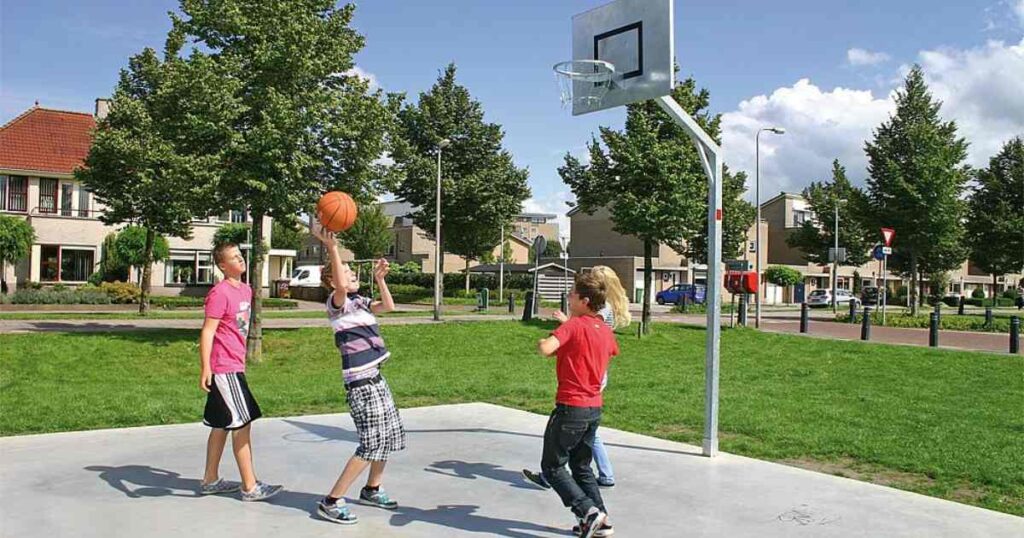Discovering the optimal height for a basketball goal is crucial for fair play and skill development. Unraveling the mystery behind the standard height enhances the game’s integrity and ensures a level playing field.
From playgrounds to professional courts, the standard height for a basketball goal is 10 feet. This universally accepted measure fosters a consistent challenge, promoting skill mastery and enabling players of all levels to engage in the sport with uniformity and excitement.
The 10-foot standard height for basketball goals, established by the NBA and other governing bodies, facilitates a consistent and challenging experience across various levels of play. This regulation not only fosters skill development but also ensures a level playing field for enthusiasts worldwide.
The 10-Foot Standard: Unveiling the Mystery
Unlocking the essence of basketball, the 10-foot standard is no mere number—it’s the heartbeat of fair play. Originating with Dr. James Naismith, it’s a universal measure fostering skill, unity, and an equal playing field worldwide.
Historical Roots and Practical Considerations
The 10-foot standard, etched into the fabric of basketball, has historical roots dating back to the sport’s inception. Dr. James Naismith, the visionary behind basketball, hung a peach basket at a height of 10 feet in 1891, aiming to strike a balance between skill and physicality.
Evolution of a Benchmark
As the sport evolved, so did the significance of the 10-foot standard. It wasn’t a mere arbitrary decision but a pivotal choice that influenced official rules and gained global acceptance. The National Basketball Association (NBA) and international governing bodies like FIBA embraced this standard, fostering consistency in the game’s regulations.
Consistency Across Levels
Seamless Transitions
The 10-foot standard ensures a uniform playing experience across various levels of the game. Whether you’re on a community court or a professional arena, the height remains constant, allowing players to transition seamlessly and focus on the game without distraction.
Skill Development and Level Playing Field
Master your game with a consistent hoop height. Whether shooting or defending, the 10-foot standard ensures fair play and equal opportunities for skill development. It creates a level playing field where every player can showcase their talents without external factors tipping the scales.
Hone Your Skills
A consistent hoop height fosters skill development. Players of all levels can refine their shooting, dunking, and defensive abilities within the same parameters. This uniformity establishes a level playing field where talent, not external factors, determines the outcome.
International Unity and Recognition
In the world of basketball, there’s a global handshake 10-foot agreement. FIBA and the Olympics echo this standard, uniting players worldwide under one hoop height, fostering a universal language of the game. This shared foundation ensures that, no matter where you play, the rules and the joy remain the same.
A Global Standard
FIBA’s alignment with the 10-foot standard promotes global unity in basketball. International competitions, including the Olympics, adhere to this standard, emphasizing a shared set of rules for basketball enthusiasts worldwide.
Exceptions and Variations

While the 10-foot standard is prevalent, exceptions and variations exist, particularly in non-professional settings.
Youth Leagues: Adjusting for Development
In youth basketball leagues, hoop heights might change to fit the players’ ages. Lowering the hoop helps kids play, learn, and love the game while keeping it safe. Adjusting for development ensures a positive and age-appropriate experience for young talents on the court.
Nurturing Young Talent
In youth basketball leagues, the standard height may be adjusted to accommodate the physical capabilities of younger players. Lowering the hoop height ensures age-appropriate competition, emphasizing skill development without compromising safety.
Recreational Courts: Embracing Diversity
Recreational courts vary. Hoops have different heights in parks and community spaces. Players adapt to diverse settings, making each game a unique experience. Embracing these differences enhances the joy of playing basketball outdoors.
Varying Hoop Heights
Outdoor courts in parks and community spaces may feature hoops installed at varying heights. Players must be aware of these differences, adapting their game when moving between different playing environments.
Impact on Player Experience: A Closer Look
The 10-foot standard isn’t just a number it’s a mental challenge. When approaching a basketball goal, players share a universal expectation, adding a psychological aspect to the game. This regulation height measures athleticism, serving as a benchmark for dunking and shooting, epitomizing the question, What Is Regulation Basketball Goal Height?
Psychological Aspect
Mental Challenge
The 10-foot standard presents a mental challenge to players, contributing to the psychological aspect of the game. Regardless of location, players share a universal expectation when approaching a basketball goal.
Physical Demands and Athleticism
Mastering basketball requires physical prowess. The 10-foot standard height serves as a measure of athleticism, testing players’ dunking and shooting skills. It ensures an equal playing field, emphasizing the universal demands of the game, regardless of the venue or skill level.
Measuring Athleticism
The 10-foot standard serves as a benchmark for measuring athletic achievement, particularly in terms of dunking and shooting accuracy. It ensures that players face equal physical demands, regardless of the venue or level of play.
Hoop Heights in Recreational Settings

In parks and community courts, hoop heights can vary, adding a fun twist to the game. Youth leagues might lower it for age-appropriate play, ensuring a safe and enjoyable basketball experience for all. Be ready to adapt your game when exploring different recreational settings
Understanding the Variations
In recreational settings, hoop heights may differ, showcasing the adaptability of the 10-foot standard.
| Location | Hoop Height Adjustment |
| Youth Leagues | Adjusted for age-appropriate play |
| Recreational Courts | Varying heights for diverse settings |
FAQs
1. Why is the standard height for a basketball goal 10 feet?
The 10-foot standard was established by Dr. James Naismith to strike a balance between skill and physicality. It has since become a globally accepted benchmark, fostering consistency and fair play.
2. Are there exceptions to the 10-foot standard?
Yes, particularly in youth leagues and recreational settings. Hoop heights may be adjusted to accommodate the age and skill levels of players.
3. How does the 10-foot standard impact international competitions?
FIBA, the international governing body for basketball, aligns with the 10-foot standard, ensuring global uniformity in rules and regulations, including those for prestigious events like the Olympics.
Conclusion
The standard height for a basketball goal, entrenched at 10 feet, is more than a numerical benchmark it’s the bedrock of the game’s integrity and global unity. From Dr. James Naismith’s visionary beginnings to its adoption by international governing bodies, the 10-foot standard symbolizes a commitment to fair play, skill development, and a shared basketball experience across diverse courts and cultures.
Embracing this standard ensures a level playing field for players of all skill levels, fostering a universal expectation that transcends borders. Whether shooting hoops in a local community or competing on the grand stage, the 10-foot standard stands tall, a testament to the sport’s rich history and its ability to unite enthusiasts worldwide in the joy of basketball.



